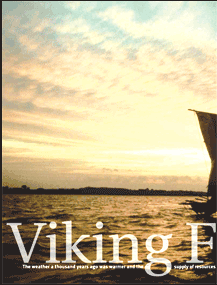
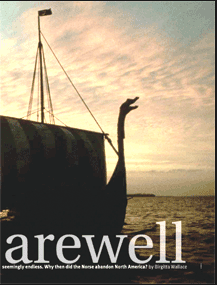
Viking Farewell
by Birgitta Wallace
The weather a thousand years ago was warmer and the supply of resources seemingly endless. Why then did the Norse abandon North America?
The last of the Vinland expeditions to the New World ended bloodily. Around A.D. 1010, Freydis, Erik the Red's daughter, persuaded two Icelandic brothers, Helgi and Finboggi, to join her expedition to Vinland by adding their own ship. They had a place to bunk, she implied: her half-brother, Leif, had built houses there already. (The location was most likely L'Anse aux Meadows.)
Freydis promised the brothers that they would share the profits from the expedition equally and agreed on an equal number of men — thirty — that each group could bring. Stealthily, she hid five extra men aboard her ship. When the travelers reached Vinland, Freydis would not allow the Icelanders' party to move into Leif's buildings, so they were forced to lug their possessions away and construct their own dwelling farther inland. Meanwhile, Freydis was having timber felled for her cargo.
When winter set in, feuding arose between the two parties. Showing tremendous audacity, Freydis approached Finnbogi and demanded to have the Icelanders' ship for the return voyage, as it was larger than hers. Likely fearing Freydis' wrath, he consented, but to no avail.
Freydis told her husband that the brothers had struck her, demanding that he avenge her honour. Her husband, unable to bear her taunts, rounded up his men and killed the Icelanders and their party. Freydis herself finished off the five remaining women.
Early in the spring, Freydis had the brothers' ship prepared, loaded it with all of the resources the vessel could carry, and sailed back to Greenland. So ended Norse exploration of Vinland.
In the Greenlanders' Saga, this is the most dramatic story, but it also contains the most fiction. If Freydis really had masterminded the killing of so many people, Icelandic law would have required matching killings of men and women in Freydis' family, and if that had happened, there probably would have been some historical record of the incident. The Vinland waters are full of shoals, and it is hard to avoid them, as so much of the conventional knowledge of Vinland and the sagas has been proven wrong over the last couple of decades.
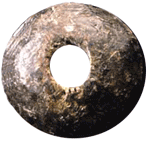
Thanks to saga research and recent archaeological work in Iceland and Greenland coupled with anthropological studies, we have a much deeper understanding of what Vinland was all about, and a whole new perspective on L'Anse aux Meadows.
According to the sagas, it was Freydis' half-brother, Leif Eriksson, who led the first Norse voyage to the New World. Promptly following that trip, in the decade beginning around A.D. 1000, four additional expeditions set sail from Greenland. Thorvald Eriksson, Leif's brother, led the first. From Leif's base in Vinland (probably L'Anse aux Meadows), he explored the coasts in several directions.

During these explorations he met aboriginals, calling them skraelings (a term that has long since disappeared from the Scandinavian languages, and for which we do not have a precise meaning today). In one of his encounters with skraelings, Thorvald was killed.
The following year, Thorsten, another brother, set out to recover Thorvald's body for burial in a Greenland cemetery, but ended up tossed on the open seas and prevented from reaching land. The third — and second-last — expedition was led by well-to-do Icelandic merchant Thorfinn Karlsefni and his wife, Gudrid. Comprising several ships, he and his party stayed for three years. It is believed that Gudrid and Thorfinn Karlsefni's son Snorri was the first European child born in North America.

Karlsefni's party met and traded for furs with aboriginals. Archaeological evidence indicates that the Norse likely met the ancestors of the Mi'kmaq in the areas where they found grapes, and the forefathers of the Innu and Beothuk in more northerly regions. While some of the first meetings were relatively peaceful, relations between the Norse and skraelings soured, and skirmishes ensued.
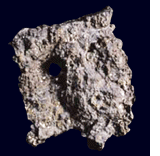
Karlsefni recognized that "there would always be fear and strife dogging them there on account of who already inhabited it." He could not have envisioned that it would be infighting, not skraeling adversaries, that would rip apart the last Vinland expedition.
Just a few years before the Norse expeditions, if anyone had been watching from the eastern shore of Canada on an early fall day around the year A.D. 986, they might have spotted a wooden ship with a large, square sail and men peering out toward land. This was the ship of Bjarni Herjolfsson, a young Icelandic trader, heading for Greenland with valuable goods from Europe. Somewhere near the southern tip of Greenland, the ship had been swept off course by storm and fog. Now that the weather had cleared, Bjarni faced an unexpected coastline of forests and rolling hills.
The crew clamoured to go ashore, but exploration would have to wait. Greenland lay to the north. Steering in that direction, they eventually landed safely in southwestern Greenland. The area had been settled by a small group of Icelanders, including Bjarni's father, earlier that year. The new colonists were intrigued by news of the sighting of land farther west, but their priority was getting established in this new and difficult land.

By the year A.D. 1000, almost fifteen years after Bjarni's chance discovery of lands to the south, the colony in Greenland, established by Erik the Red, was thriving. Farms spread through the verdant valleys of the east and west settlements. Erik's oldest son, Leif, led the first expedition to explore the new lands to the west. Travelling south from the Arctic coasts, Leif observed distinct changes and gave names to three regions according to their physical characteristics.
Farthest to the north was Helluland, Land of Large Stone Slabs (thought to have been all land north of the treeline in northern Labrador, including Resolution and Baffin Islands). A couple of days' sailing to the south was Markland, Land of Forests (probably Labrador). Continuing down the coast, he arrived at what he thought was a suitable base camp for further exploration and named it LeifsbÖ?ir, "Leif's Camp." Later, when Leif decided to spend the winter there, he ordered the construction of large, permanent dwellings.
Systematic exploration of the surrounding areas ensued. Leif's men found excellent building timber, which they cut as the main cargo to bring back to Greenland. On one of the reconnaissance trips, grapes were discovered growing in the woods. So significant was this discovery that Leif named this third land Vinland, Land of Wine (probably the coasts of the Gulf of St. Lawrence).
Leif returned to Greenland after a couple of years. Upon the death of Erik, he assumed the role of chief. Leif did not accompany the four following expeditions to Vinland, but as chief, Leif retained control through his family.
The Norse soon found that the land was inhabited. In the Greenlanders' Saga Leif's brother, Thorvald, sailing to the west, came upon a wooden drying frame, which looked like a hayrick. The next year, exploring to the north and east, he and his men found three skin boats with three men sleeping under each. Without provocation, they killed all but one. Returning to their ship, warriors in a large number of skin boats attacked them, and Thorvald was killed.
The aboriginals were especially numerous in the area of wild grapes. The first encounter with them resulted in trade. The Norse offered milk (or red cloth) in return for grey squirrel skins, marten, and other fine furs. For the Norse, everything in the new land was unexpected. For the aboriginals, the appearance of a completely different people on their shores must have been quite a surprise.
The next time they met the Norse, fighting broke out and people were killed. The Norse felt that they were poorly equipped to fight the inhabitants. Although they had come to a rich land, a prolonged stay was not worth the difficulties, so they returned home. The connection to Vinland proved too difficult for the small Greenland colony to sustain, and it slipped into folklore, a mythical paradise somewhere to the west.
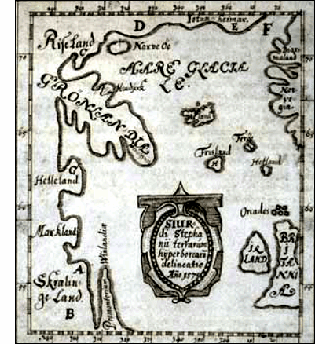 THE VINLAND SAGAS
THE VINLAND SAGASThe Vinland sagas became widely known to the scholarly world in 1837 and 1838 when Danish antiquarian Carl Christian Rafn published them in Latin and English. He speculated that Vinland may have been in the border area between Massachusetts and Rhode Island. His conclusions relied primarily on two points: the presence of grapes and a sun observation stating that on the shortest day of the year, daylight was longer than in Iceland and Greenland.
Rafn never visited North America; he solicited information on Norse phenomena by corresponding with American colleagues. A small, round stone tower in Newport, Rhode Island, and a rock with carvings at Dighton, Massachusetts, were identified as Norse. The tower was declared a Norse church and the Dighton rock was believed to be a rune stone. Today, we know that the carvings on the Dighton rock are aboriginal, and the tower only dates back to the mid-seventeenth century. Even so, Rafn's identifications are still considered valid by many, and New England remains the most popular candidate for Vinland.
The first to suggest that Leif's settlement had been on the northern tip of Newfoundland's northern peninsula was William Munn in 1914. Danish archaeologist J»rgen Meldgaard had the same idea and conducted exploratory excavations about twenty-five kilometers west of L'Anse aux Meadows in 1956. Four years later, Norwegian explorer and writer Helge Ingstad arrived at L'Anse aux Meadows, where locals led him to the remains of turf walls from large buildings. Ingstad began excavations headed by his archaeologist wife, Anne Stine Ingstad, which lasted until 1968, verifying that it was a Norse settlement. In 1968, the site was declared a National Historic Site of Canada under the management of Parks Canada.
Theories placing Vinland in New England and farther south have been partly based on the false idea that this was the northern limit for wild grapes. In reality, their limit is in eastern New Brunswick inland from the Bay of Chaleur and along the Miramichi River Valley. People at L'Anse aux Meadows visited these areas in the summer and early fall.
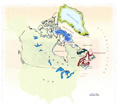
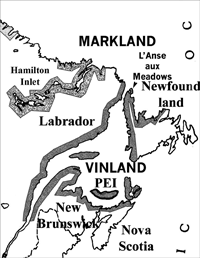

Northeastern New Brunswick could be the site of H█p, the southern camp. The name itself refers to shallow tidal lagoons behind sandbars. Such sandbars and lagoons exist along the entire coast of New Brunswick. Butternuts (found among Norse debris at L'Anse aux Meadows) grow along the Miramichi River, the richest area along the coast, as do wild grapes.
When the archaeological and saga evidence are combined, Vinland emerges as the coastal land surrounding the Gulf of St. Lawrence. The southern gulf offers large hardwood forests, warm waters, and summer temperatures equal to those of southern Europe.
Theorists of a more southerly Vinland fail to realize that the southern gulf area offered a lush environment full of resources for the Greenland colonists, and was much closer to home. Finally, it was at H█p that the Norse encountered the largest groups of aboriginals, and the Miramichi area has been home to some of the largest groups of aboriginal people in Atlantic Canada. Mi'kmaq at Metepenagiag (Red Bank) have lived in the area for at least 3,000 years. The aboriginal people the Norse met at H█p travelled in skin canoes. Such canoes were rarely found south of central Maine and not at all south of northern Massachusetts.
WHY DID THE NORSE LEAVE?
- The chief factor was demography. At the time of the voyages the entire Greenland colony had no more than about four or five hundred people. Leif's Greenland was too young and small a settlement to support a distant colony.
- There was no pressure for expansion. The population was sparse and spread over huge areas, with plenty of land still available. The rich areas of Vinland were as far away as Norway, and the journey more complicated and dangerous. Communications with Norway had to be maintained for essential supplies and for cultural, personal, and religious ties.
- There were too few ship owners to carry on a long-distance trade in two completely opposite directions. The fact that Vinland was already inhabited was also a consideration. The Greenlanders turned their eyes north to the walrus hunt for hides and ivory, which were easy to ship to Europe and which had great value in trade.
L'ANSE AUX MEADOWS
Where does L'Anse aux Meadows fit within the Vinland sagas? L'Anse aux
Meadows is not a typical Norse settlement. Most Iceland and Greenland
people lived on individual farms, isolated from their neighbours. Each
farm had a family house and buildings for sheltering the sheep, cattle,
horses, and hay.
At L'Anse aux Meadows, we find a high concentration of living quarters, including three large dwellings and four smaller houses. The site lacks evidence of shelters for livestock and fodder, but does include an iron-smelting hut. A concentration of living quarters was rare — this was not a place for farming and raising families, but a seasonal stopover between Greenland and the southern parts of Vinland.
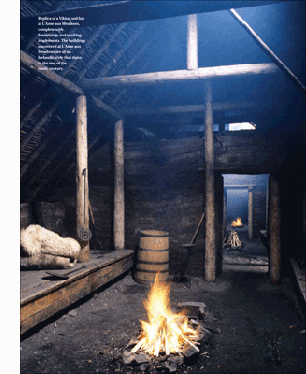
The buildings uncovered at L'Anse aux Meadows are of a distinctly Icelandic style that developed toward the end of the tenth century. The walls were constructed of sod laid over a wooden frame. The heavy roofs, also of sod, were supported by rows of interior posts.
With the exception of one hut where iron was produced, the buildings were primarily dwellings. Three houses were large "halls" of the kind used only by chieftains and the prosperous. The largest, more than three times the size of Erik the Red's home recently excavated in Iceland, was truly a chieftain's house, used by the leader of the expeditions. It had six rooms and an attached work shed.
Aside from two communal living/sleeping rooms, it also contained private living quarters. On the first expedition, this would have been Leif's house, later used by his brother Thorvald, by Thorfinn Karlsefni and Gudrid, and finally by Leif's half-sister Freydis and her husband. The other two halls were also imposing structures resembling elite homes in Iceland and Greenland where the lord of the manor surrounded himself with a large staff of domestic and hired workers. The remaining dwellings were small, the kind used by labourers and slaves, mirroring the stratification of Norse society.
The Vinland adventure was not a colonizing enterprise. The sagas are clear that the chief motivation was to search for resources needed in the home colony. The expeditions were work crews hired for one expedition, not families expecting to stay.
The Strait of Belle Isle serves as a natural funnel into the Gulf of St. Lawrence for the traveller from the north. L'Anse aux Meadows sits on the western side of the tip of the northern peninsula, facing the Strait. This site was chosen not as a harbour, but because it provided access to Vinland. The only other Norse site that corresponds to the layout and function of L'Anse aux Meadows is found not in the archaeological record but in the Vinland sagas.
L'Anse aux Meadows is too large and substantial not to be one of the sites mentioned, and it corresponds in all respects to Straumfjord of Erik's Saga, the base camp at the northern edge of Vinland, and in part LeifsbÖ?ir of the Greenlanders' Saga.
Here, Leif Eriksson ordered the large dwellings built, and here Gudrid gave birth to Snorri.

- Bengt Schonback, a Swedish Viking Age expert,
was chosen to lead the L'Anse aux Meadows excavations from 1973 to
1976. When he returned to Sweden in 1975, Birgitta Wallace was placed
in charge of the final year of excavations and has been the
archaeologist for the site ever since. Her new book on L'Anse aux
Meadows and Vinland was published in November 2006, called Westward
Vikings, The Saga of L'Anse aux Meadows.
- Post comments or read others' thoughts about this article on the History Society blog.
- Test your Viking knowledge with an online game, in the vein of "So You Want to Be a Millionaire?"
- Sail over to the Smithsonian's Viking site.
- Buy a Beaver back issue with other related articles: "Vikings at Play" by David Gardner, August/September 1997; "Before Columbus: Early European Visitors to the Shores of the New World" by Robert McGhee, June/July 1992; or view "The First Europeans in America" by Gwyn Jones, Winter 1964.
- Read Vinland Revisited: The Norse World at the Turn of the First Millennium edited by Shannon Lewis-Simpson, Historic Sites Association of Newfoundland and Labrador, Inc., St. John's, 2002.

Subscribe now
and read our other articles, "Sensational Maud Allan: Pioneer of Modern
Dance," "The Canadian Reindeer Project" and "The Ballad of John &
John & Yoko."
This article was published in the December 2006/January 2007 issue of the Beaver.







